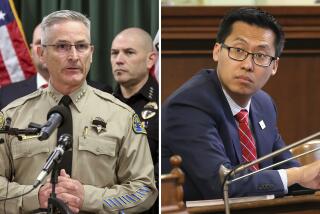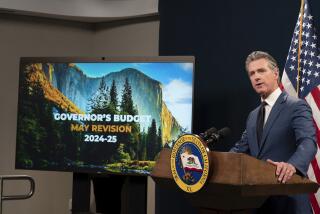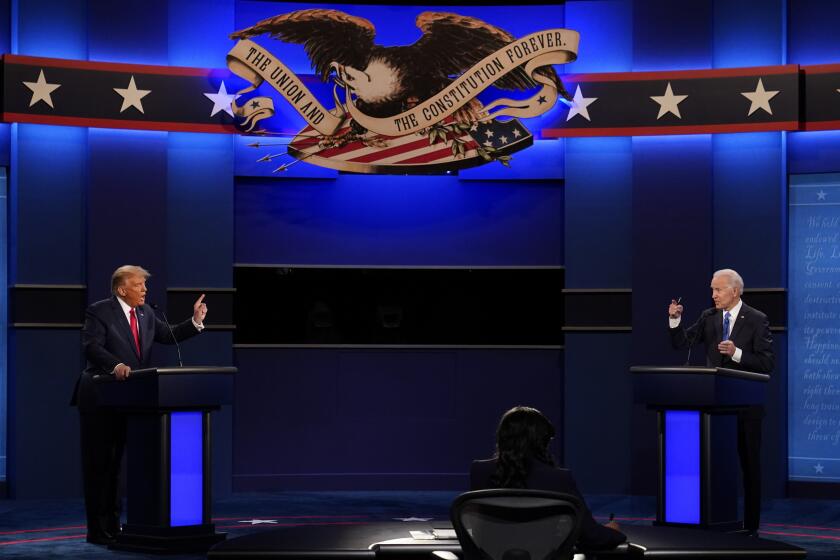Crafting Assault Weapon Ban No Easy Task
All along the campaign trail this year, Gov.-elect Gray Davis, Atty. Gen.-elect Bill Lockyer and virtually every other victorious Democratic candidate offered the same promise: They would make California safer by ridding the streets of assault weapons.
Now, a month after the election that gave Democrats solid control of the state Capitol, they must confront the task of turning that lofty campaign pledge into a law.
For the record:
12:00 a.m. Dec. 17, 1998 For the Record
Los Angeles Times Thursday December 17, 1998 Home Edition Part A Page 3 Metro Desk 1 inches; 28 words Type of Material: Correction
Assault weapons--In a Dec. 14 Times article about pending assault weapons legislation, the county of a member of Atty. Gen.-elect Bill Lockyer’s task force was misidentified. It is Modoc County.
Based on their numbers, Democrats will be able to pass virtually any bill that Davis and legislative leaders want. When they convene next month, Democrats will hold majorities of 25-15 over the Republicans in the Senate, and 47-32 in the Assembly.
But passing a bill is one thing. Writing a bill that will take such high-capacity weapons off the streets, can be enforced and will withstand court attacks may not be such a snap.
Television images of assault weapons aside, legislators and lobbyists have been fighting for a decade over how to define them. Pro-gun lobbyists, arguing that any effort to limit such weapons threatens the rights of all owners, revel in their ability to pick apart any effort to prohibit high-capacity, military-style firearms.
“When all the election hype was done, there was this sober realization: ‘We’ve got to produce,’ ” said National Rifle Assn. lobbyist Steve Helsley. “I’m getting no small amount of glee from this. Bills are going to Davis. There’s no question about that. But what will they do? You can’t write these bills so they will work.”
Sen. Don Perata (D-Alameda) shrugs off such comments. He has been advocating an assault weapons ban since his days as an Alameda County supervisor more than a decade ago, and he has heard all the arguments. Wasting no time, Perata introduced the year’s first bill to ban assault weapons last week, on the day he was sworn in.
Perata knows the burden is on Democrats to deliver. “Nobody wants to have something symbolic. We want to make it work.”
Lockyer quickly stepped into the fray, too. Perhaps more than any candidate, Lockyer used his opposition to assault weapons to win office.
His sole campaign commercial used footage of the North Hollywood shootout and repeated the message that he would champion an assault weapons ban. Lockyer, who will be sworn in next month, has established a task force to draft suggestions for legislation or perhaps help refine Perata’s bill.
“That was a key issue during the campaign,” said Lockyer, “and I intend to do my best to keep that commitment.”
Lockyer, who spent 25 years in the Legislature and became its most powerful Democrat, no longer has a vote in the Capitol. But the attorney general-elect points out that his deputies will be responsible for helping to enforce and defend any law that emerges.
“We’re not the policymakers,” Lockyer said. “I would hope, though, that if there is some elegance and logic to the suggestions that would come from [the task force], it would be persuasive with policymakers. We’re only going to supply ideas to the Legislature and governor’s office. They can take them or not. It’s up to them.”
Lockyer and Perata say that they are working in concert. Lockyer’s committee includes a Perata aide who works on the senator’s assault weapons bill. The two veteran politicians have known each other for 30 years. They got their start by working as staffers for the same East Bay assemblyman.
“I have no doubts we are on the same page,” Perata said. But he’s eager to move quickly. “I’m not really a task force kind of guy,” he said. And he wants to make certain that no one on Lockyer’s committee “is confused that this is a blank piece of paper and we’re starting from scratch, because we’re not.”
“I’m not going to be tripping over any chalk line,” Perata said. “Gray Davis has been very clear. He has said publicly and privately, ‘Get me that as soon as you can,’ and I’m going to do it. [Lockyer’s committee members] aren’t going to stop it, slow it down or otherwise impede it.”
The Perata-Lockyer endeavors are taking place 10 years after Patrick Purdy stepped onto the playground of Cleveland Elementary School in Stockton on Jan. 17, 1989. With an AK-47 knockoff, Purdy fired 106 rounds in less than two minutes, killing five children and wounding 29 other people.
Earlier Restrictions Before Supreme Court
More than any other event, that massacre fueled the push to ban assault weapons. The California Legislature responded by approving the nation’s first restrictions on semiautomatic assault weapons. The federal government also cracked down on imported military-style weapons. Congress approved legislation by Sen. Dianne Feinstein (D-Calif.) in 1994 to further restrict such firearms.
A decade later, however, the debate goes on. Three major cases challenging key aspects of California’s 1989 law, which restricted 75 specific assault rifles and pistols, are pending before the California Supreme Court.
Deputy Atty. Gen. John A. Gordnier, who is handling the cases for the state, predicts that the court will hear arguments on the cases by February and issue its rulings shortly afterward. The rulings, he said, should help guide the debate about how far California can go in limiting such weapons.
The battle over assault weapons also plays itself out on Lockyer’s task force. The group met for the first time Wednesday in a cramped conference room at the state Department of Justice headquarters where Lockyer has his transition office.
The committee is heavily weighted toward advocates of stricter gun control. It includes the head lobbyist in California for Handgun Control Inc., one of the leading gun control groups, and several law enforcement officials who want to limit the firepower of criminals.
But to deliver on the promise, Lockyer is also including gun advocates.
“They understand that this isn’t a forum for substantial debate about the wisdom of the policy,” Lockyer said of his task force. “This is a forum to implement a sound policy. I’ve always thought you often learn as much from your opponents as from your supporters.”
Helsley, the NRA’s Sacramento lobbyist, is one. He is a former state Department of Justice official who helped write the 1989 law. Also on the committee is the Mono County sheriff, a life member of the NRA who, in his Stetson hat, looks every bit the rural sheriff he is. And there is veteran radio reporter Pete Demetrio, of KFWB-AM (980), a gun enthusiast who caught Lockyer’s attention during the campaign by peppering the candidate with questions about his assault weapons stand.
In the first meeting, Helsley and his allies insisted, as they have repeatedly during the past decade, that there is no such thing as an “assault weapon.” The guns that the politicians decry are merely semiautomatic rifles and pistols that, with various attachments, are made to look like military-issue firearms.
“It’s a made-up term--a media term, a political term,” said Eugene Wohlberg, a forensic scientist who works for the San Diego Police Department, and is also on Lockyer’s committee.
Wohlberg, who opposes the ban, said that in his experience, gun-related injuries and deaths rarely involve more than three shots. “Gunfights happen in movies,” he said. “People spend far too much time watching television.”
He and some other experts contend that so-called assault weapons are rarely used in crime, though statistics on the criminal use of such weapons are sparse. Gun control advocates counter that assault weapons are often purchased specifically for criminal acts, and are the weapons of choice in the worst massacres.
“I’ll tell you what,” said Los Gatos Police Chief Larry Todd, co-chairman of Lockyer’s committee, “you go on the street and I’ll start shooting at you with one of these guns, and you tell me whether or not it’s an assault weapon. We’re talking about weapons of high capacity.”
One of the committee’s first orders of business was to parse Perata’s bill, SB 23.
The legislation is similar to a measure he pushed during the last two years. After it stalled in 1997, Perata rewrote it and pushed it through the Legislature this year, only to have Gov. Pete Wilson veto it, saying that it did not go far enough.
In its latest incarnation, the bill, 30 pages long, would ban the sale and possession of semiautomatic weapons that have fixed magazines holding more than 10 bullets. It also would ban the sale of new magazines that hold more than 10 rounds.
Characteristics of Assault Weapons
One problem confronting gun control advocates is that untold numbers of magazines currently in circulation hold far more than 10 rounds.
Perata’s bill would not make it illegal to possess magazines of more than 10 rounds. But it would be illegal to sell used magazines or give them away. Federal law already bans importation and manufacture of such large-capacity magazines.
Additionally, Perata’s bill would ban semiautomatic weapons that can accept detachable magazines, and have any one of a variety of other military-type characteristics designed to make the weapons easier to conceal, or fire in a sweeping motion.
One such feature would be an extra “vertical” hand grip.
No one on the committee had time to read the legislation fully. Still, gun control opponents scanned it, and began picking it apart.
Wohlberg pointed out that the definition of “vertical,” means a 90-degree angle. Gun makers could evade the law by simply redesigning their weapons with grips that are at an 89% angle, he said.
Helsley produced a photo of a deer rifle. “Basic 1-A deer rifles” would be prohibited, according to his reading of the bill, because they can accept detachable magazines.
After two hours of such talk, Merced County Sheriff Tom Sawyer mused that the discussion was “too much fun,” and drew it to a close. He and Los Gatos Chief Todd, and a few other members of the committee, will begin work on what they hope to see in the legislation, and report back to the full committee next month.
Gun control advocates will be watching. “We expect [the Democrats] to deliver what they promised.” said Luis Tolley of Handgun Control. “They made very clear promises, and we’re going to hold them to that.”
More to Read
Get the L.A. Times Politics newsletter
Deeply reported insights into legislation, politics and policy from Sacramento, Washington and beyond. In your inbox three times per week.
You may occasionally receive promotional content from the Los Angeles Times.






